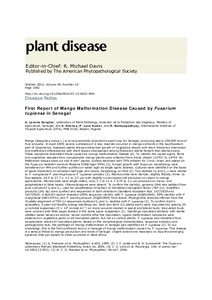| dc.contributor.author | Senghor, A.L. |
| dc.contributor.author | Sharma, K. |
| dc.contributor.author | Kumar, P.L. |
| dc.contributor.author | Bandyopadhyay, Ranajit |
| dc.date.accessioned | 2019-12-04T11:07:44Z |
| dc.date.available | 2019-12-04T11:07:44Z |
| dc.date.issued | 2012-10 |
| dc.identifier.citation | Senghor, A.L., Sharma, K., Kumar, P.L. & Bandyopadhyay, R. (2016). First report of mango malformation disease caused by Fusarium tupiense in Senegal. Plant Disease, 96(10). |
| dc.identifier.issn | 0191-2917 |
| dc.identifier.uri | https://hdl.handle.net/20.500.12478/1555 |
| dc.description | Article Purchased |
| dc.description.abstract | Mango (Mangifera indica L.) is an economically important export crop for Senegal, producing about 100,000 tons of fruit annually. In April 2009, severe outbreaks of a new disorder occurred in mango orchards in the southeastern part of Casamance. Diseased plants showed abnormal growth of vegetative shoots with short thickened internodes and malformed inflorescence with short leaves interspersed among thickened sterile flowers that aborted early. These symptoms resembled those caused by mango malformation disease (4). To identify the causal agent, floral and vegetative samples from symptomatic mango plants were collected from Kolda district (12°53' N, 14°56' W). Malformed tissues were cut into 4-mm2 pieces, surface sterilized with 75% ethanol for 2 min, dried, and plated on the Fusarium isolation medium Peptone PCNB Agar (PPA) (2). Fungal growth with Fusarium morphology were transferred on PPA and further purified on water agar as single spore isolates. Cultures were identified on the basis of spore characters on carnation leaf agar and colony morphology on PDA (2). Two isolates (I4 and I17) were similar to F. mangiferae/F. sterilihyphosum/F. tupiense complex (3). Macroconidia were slender, slightly falcate, three- to five-septate, 18.5 to 27.7 × 1.1 to 2.3 μm with slightly curved apical cell produced on cream to orange sporodochia. Microconidia were single-celled, oval, 3.7 to 13.6 × 0.75 to 1.1 μm produced on mono- and polyphialides in false heads. Chlamydospores were absent. To confirm the identity, genomic DNA was isolated from pure cultures of I4 and I17, used for amplification of portion of translation elongation factor (TEF-1α). Amplified products (241 bp) were purified and sequenced in both directions (GenBank Accession Nos. JX272929 and JX272930). A BLASTn search revealed 100% sequence identity with F. tupiense (DQ452860), 99% identity with F. mangiferae (HM135531) and F. sterilihyphosum (DQ452858) from Brazil. Phylogenetic analysis inferred from the Clustalw alignment of TEF-1α sequences clustered I4 and I17 isolates with F. tupiense (3). To confirm Koch's postulates, 2-year-old healthy mango seedlings var. Keitt and Kent (12 plants each) were inoculated by placing 20 μl conidial suspension (5 × 107 conidia ml–1) on micro-wounds created in apical and lateral buds. Inoculated buds were covered with filter paper soaked in the same spore suspension (1). Seedlings inoculated similarly with sterile distilled water served as control. Seven months after the inoculation, typical malformation symptoms were observed on vegetative parts on all inoculated plants, but not on control plants. F. tupiense was reisolated from symptomatic shoots of inoculated plants. Based on the morphological characteristics, sequence analysis, and pathogenicity test, the pathogen of mango malformation in Senegal was identified as F. tupiense (3). To our knowledge, this is the first confirmed record in Senegal of mango malformation caused by F. tupiense. This disease is a serious threat to mango production and trade of Senegal. Urgent actions are necessary to stop this emerging epidemic that can spread to other countries in West Africa. |
| dc.language.iso | en |
| dc.subject | Mango |
| dc.subject | Diseases |
| dc.subject | Fusarium |
| dc.subject | Symptoms |
| dc.subject | Malformation |
| dc.title | First report of mango malformation disease caused by Fusarium tupiense in Senegal |
| dc.type | Journal Article |
| dc.description.version | Peer Review |
| cg.contributor.crp | Agriculture for Nutrition and Health |
| cg.contributor.affiliation | Ministry of Agriculture, Senegal |
| cg.contributor.affiliation | International Institute of Tropical Agriculture |
| cg.coverage.region | Africa |
| cg.coverage.region | West Africa |
| cg.coverage.country | Senegal |
| cg.isijournal | ISI Journal |
| cg.authorship.types | CGIAR and developing country institute |
| cg.journal | Plant Disease |
| cg.howpublished | Formally Published |
| cg.accessibilitystatus | Open Access |
| local.dspaceid | 82116 |
| cg.identifier.doi | https://dx.doi.org/10.1094/PDIS-07-12-0623-PDN |

